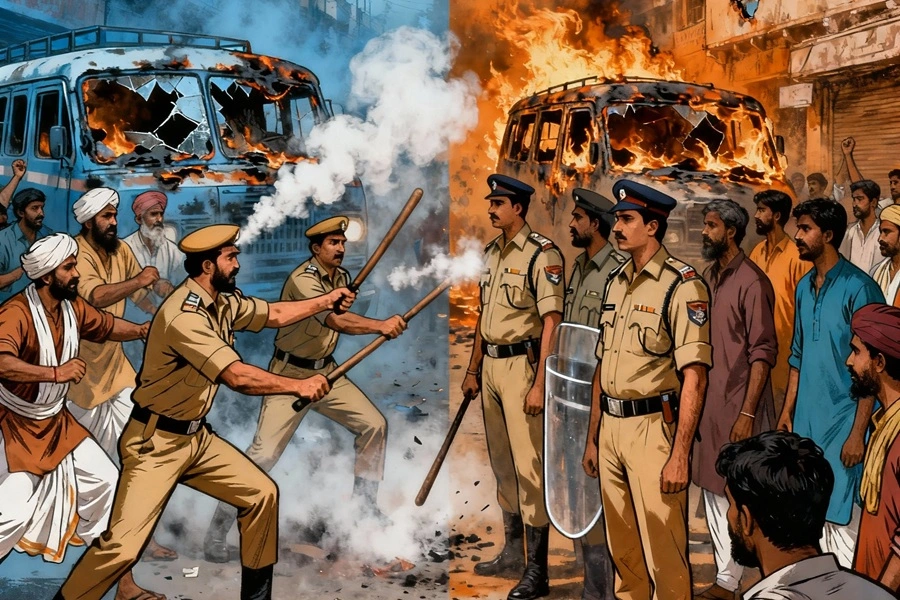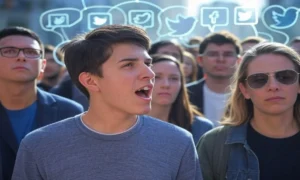Communal riots in India are not merely spontaneous eruptions of violence; they often reflect underlying systemic failures in law enforcement and governance. Selective enforcement—the inconsistent or biased application of legal provisions—has emerged as a critical factor that exacerbates communal tensions.
When authorities act with prejudice, delay interventions, or selectively prosecute offenders based on identity or political pressure, public trust in institutions erodes, fueling cycles of revenge and unrest.
UP Police have been accused of selectively targeting minorities, particularly Muslims, during communal riots, such as the 2025 Kanpur and Bareilly clashes over “I Love Muhammad” posters. Arrests and FIRs disproportionately affect one community, escalating tensions.
In this article, we will explore how selective enforcement shapes the causes, patterns, and escalation of communal riots in India, examining the legal mechanisms at play and their broader implications for justice, equality, and democratic accountability.

How Selective Enforcement Fuels Communal Riots in India: Causes, Patterns and Legal Implications
Communal riots have long haunted India’s socio-political fabric, erupting time and again in different corners of the country—from Muzaffarnagar in 2013 to Delhi in 2020 and Manipur in 2023. Each episode leaves behind not just human tragedy, but also uncomfortable questions about the role of state institutions meant to protect citizens.
Central to this discussion is the idea of selective enforcement—the uneven or biased application of law by police and administrative authorities.
Unlike mere negligence or inefficiency, selective enforcement reflects conscious or systemic bias, where laws are applied stringently against one group while conveniently overlooking violations by another. This selective use of state power does more than distort justice—it deepens communal divides, legitimizes violence, and corrodes public faith in the rule of law.
Let’s examine how such practices, rooted in institutional and political biases, have historically shaped the trajectory of communal riots in India through legal frameworks, real-world case studies, and their broader socio-political implications.
Historical Context of Communal Riots and Law Enforcement in India
India’s communal tensions did not emerge overnight; they are deeply entwined with its historical evolution. From colonial strategies of division to post-independence administrative failures, law enforcement has often mirrored the prejudices and politics of its time rather than upholding impartial justice.
Colonial Legacy
The British colonial administration institutionalized communal divisions as a tool of control, classifying populations along religious lines and nurturing mistrust between communities.
Through the “divide and rule” policy, communal identities were politicized, and law enforcement was tailored to manage, not heal, conflicts.
Police forces were structured to protect colonial interests, not public harmony, creating a legacy of coercive control. This systemic bias laid the foundation for communal policing practices that continue to echo in India’s post-colonial governance.
Post-Independence Continuity
After independence, India retained much of the colonial policing architecture, and with it, its hierarchical mindset.
During major riots—from the 1984 anti-Sikh violence to Gujarat 2002—law enforcement agencies often displayed selective inaction or complicity. Instead of being protectors, police sometimes became participants, guided by political pressure or communal bias.
The persistence of impunity, weak prosecution of officials, and lack of independent oversight ensured that the same patterns of selective enforcement persisted across decades, undermining trust in the state’s neutrality.
Evolution of Law Enforcement Structures
India’s legal system, anchored in the IPC and CrPC, provides detailed provisions to prevent and control riots. Yet, institutional reform has lagged far behind legal ambition.
Despite commissions and Supreme Court directives, police autonomy remains compromised by political interference.
Riot-control mechanisms often activate reactively rather than preventively, reflecting administrative inertia.
Accountability for failures is rare, and internal investigations seldom lead to reform. Thus, while the laws exist on paper, their enforcement continues to be shaped by bias, bureaucracy, and selective will.
Understanding Selective Enforcement
Selective enforcement lies at the heart of how justice is bent to serve prejudice. It is not always about breaking laws, but about how, when, and against whom the laws are applied—revealing a deeper, institutionalized pattern of partiality.
Mechanisms of Selectivity
Selective enforcement manifests through everyday policing decisions—who gets arrested, whose complaint is registered, and when the police choose to act.
Disproportionate arrests, biased FIR filings, and delayed deployment during riots are not coincidences but calculated responses shaped by communal or political considerations.
While one community may receive immediate police protection, another faces neglect or suspicion. Such uneven application of state power transforms the law from a shield of justice into a weapon of discrimination, intensifying conflict and eroding trust in impartial governance.
Institutional Bias
Institutional bias thrives in the nexus of local policing networks, political interference, and administrative complicity. Officers often operate within informal hierarchies where loyalty to power outweighs duty to law.
Political actors influence investigation priorities, transfers, and promotions, subtly directing the police to favor certain groups.
Over time, this culture embeds bias deep within the system, making discrimination seem normal rather than deliberate. The institution thus ceases to act as an independent arbiter and instead becomes an instrument of selective justice.
Legal Shielding and Impunity
Laws meant to protect public servants, like Section 197 of the CrPC, often become shields for misconduct. This provision requires government approval before prosecuting officials, effectively stalling accountability.
Departmental inquiries, when conducted, tend to be perfunctory, rarely resulting in meaningful punishment.
The combination of procedural safeguards and political patronage creates a culture of impunity, where biased enforcement carries no consequence. This legal insulation emboldens officials to act selectively, knowing the system will protect them rather than hold them accountable.
Media and Narrative Control
In the age of 24/7 news and social media, control over the narrative is as crucial as control over the law.
Selective leaks, staged press briefings, and biased reporting amplify official versions while silencing victims.
By portraying one community as aggressors and the other as victims, media narratives legitimize selective policing. This manipulation shapes public perception, diverts scrutiny, and provides moral cover for injustice.
When truth itself is filtered through bias, selective enforcement becomes easier to justify and harder to challenge.
Causes of Selective Enforcement in India During Communal Riots
Selective enforcement during communal riots in India stems from a complex interplay of political, institutional, and societal factors.
One major cause is political pressure, where ruling parties may influence law enforcement to protect their voter base or suppress dissent.
Institutional bias within police forces—often shaped by historical prejudices or lack of diversity—can lead to disproportionate action against marginalized communities.
Media narratives also play a role, sometimes amplifying one side while downplaying the other, shaping public perception and justifying selective action.
Legal loopholes and vague definitions in riot-related laws allow discretionary power, which can be misused.
Additionally, lack of accountability mechanisms and weak oversight embolden selective practices.
Societal polarization, fueled by identity politics and misinformation, further deepens enforcement disparities.
These factors create an environment where justice becomes uneven, eroding public trust and exacerbating communal tensions rather than resolving them. Addressing these root causes is essential for equitable law enforcement.
Case Studies
Case studies reveal how selective enforcement transforms law into an instrument of bias. Each riot tells a story not only of violence but of the state’s choices—when it acted, whom it protected, and whose suffering it chose to overlook.
Gujarat Riots 2002
In 2002, Gujarat witnessed one of India’s darkest chapters of communal violence, intensified by administrative paralysis.
The delayed army deployment and absence of timely police intervention allowed mobs to act with impunity.
The Special Investigation Team (SIT) and Supreme Court later noted lapses and complicity at multiple levels.
Selective prosecution and protection of powerful figures reinforced the perception that justice was negotiable. This riot became a textbook case of how inaction and bias from the state can magnify tragedy into systemic failure.
The case of Zakia Jafri exemplifies the challenges in seeking justice. After the SIT closed investigations into 63 accused, including then Chief Minister Narendra Modi, Jafri filed a protest petition. However, the Supreme Court upheld the SIT’s closure report, citing procedural adequacy but not addressing the substantive concerns raised by Jafri.
Muzaffarnagar Riots 2013
The Muzaffarnagar riots reflected the dangerous intersection of politics and policing. Despite early signs of tension, authorities failed to prevent escalation.
Reports revealed that police protection was uneven—villages of one community were swiftly secured, while others were left vulnerable.
Political rallies following the violence further polarized sentiments, influencing how cases were filed and pursued.
Selective prosecution ensured that accountability remained elusive. The episode showcased how communal violence can be manipulated for electoral gain, with the law reduced to a political instrument.
In the aftermath, the Uttar Pradesh government withdrew riot-related cases against prominent political figures, including BJP MLA Sangeet Som and VHP leader Sadhvi Prachi, citing a lack of evidence. This move raised concerns about the state’s commitment to impartial justice.
Delhi Riots 2020
The Delhi riots unfolded under the shadow of political polarization, and law enforcement mirrored that divide.
Investigations and arrests disproportionately targeted one community, while inflammatory speeches by political figures went largely unpunished.
The selective use of stringent laws like UAPA against protestors, rather than instigators, highlighted bias in application.
Courts later noted inconsistencies and lack of evidence in several cases, exposing a troubling pattern: the state’s machinery was not just slow to act—it was selectively active, shaping both justice and perception.
Manipur Violence 2023
The 2023 Manipur violence unfolded in the digital age, where selective enforcement extended beyond the streets into cyberspace.
Despite widespread reports and viral footage of atrocities, authorities appeared paralyzed, with internet shutdowns silencing victims rather than protecting them.
Law enforcement’s delayed action and differential response across regions exposed administrative partisanship.
Selective arrests and narrative control deepened ethnic fault lines. Manipur became a modern reminder that bias in enforcement—amplified by information control—can turn a local conflict into a humanitarian and governance crisis.
Haldwani Riots, Uttarakhand (2024)
A court-ordered demolition of an unauthorised madrasa triggered violent clashes in Haldwani. At least six people died and over 250 were injured.
Law enforcement response included arrests, curfew, heavy police deployment. This incident raises questions on how demolition orders, timing, and community protection decisions were handled.
Was the state equally rigorous in demolitions elsewhere? Which communities’ structures were removed? How quickly did police respond once violence began?
Sambhal Violence, Uttar Pradesh (2024)
In Sambhal district, a court-ordered survey by the Archaeological Survey of India of a centuries-old mosque triggered communal clashes. At least five people died and around thirty were injured.
Key issues include: Was the surveying process handled with prior consultation? Did police act fast to prevent escalation? Did enforcement agencies treat both sides equally, or was there bias in deployment, arrests, or narrative control?
Nagpur Violence 2025
In March 2025, communal tensions erupted in Nagpur after right-wing groups protested to remove a historical tomb of Aurangzeb.
Violence escalated, houses were demolished, arrests were made, and local civic authorities demolished one accused’s home amid legal pushback. This incident raises questions about whose demands are responded to swiftly by police and civic bodies, and whether administrative action is tempered by political ideology.
Selective deployment of law, demolition notices, and response speed hint at enforcement that aligns with ideological pressure rather than equal application of the law.
Murshidabad Violence 2025 (West Bengal)
In April 2025, protests against the Waqf (Amendment) Act triggered violence in Murshidabad district.
Homes were damaged, arrests made, internet suspended, and central forces were deployed after a High Court order.
Critics alleged uneven police responses and administrative bias in handling the riot aftermath.
The escalation from protest to violence, together with how enforcement actions (such as using internet shutdowns, arrests, or property protection) were carried out, can be studied to uncover patterns of selective enforcement.
Consequences of Selective Enforcement
Selective enforcement doesn’t merely distort justice—it reshapes society’s moral compass. When the law bends toward bias, it corrodes institutions, divides communities, and rewards political opportunism. The ripple effects extend beyond borders, staining India’s democratic image on the global stage.
Erosion of Rule of Law
The rule of law survives on the belief that justice is impartial and accessible to all. Selective enforcement destroys this foundation, creating a perception that laws are tools of power, not protection.
When citizens witness biased policing or skewed prosecutions, faith in justice institutions erodes. Over time, bias becomes normalized within enforcement culture—officers learn which side to favor, and citizens learn whom the law serves. The result is a fragile democracy where legality is contingent upon identity, not equality.
Social Polarization
Selective enforcement deepens social divides by reinforcing communal stereotypes of “victims” and “perpetrators.”
When the state’s actions appear partial, communities retreat into suspicion and resentment. Each riot or biased investigation widens the psychological distance between groups, turning neighbors into adversaries.
Instead of healing, the law becomes an instrument of exclusion. Such polarization fuels cycles of revenge, where each side justifies hostility as self-defense, ensuring that communal peace remains a temporary illusion rather than a sustained reality.
Political Gains and Vote-Bank Consolidation
Selective enforcement often serves political calculations rather than public welfare. By shielding certain groups and targeting others, ruling powers signal allegiance to specific voter bases. This manipulation converts justice into a campaign strategy—rewarding loyalty and punishing dissent.
During elections, narratives built around selective law enforcement can polarize electorates, consolidating votes through fear or resentment.
The tragedy is that governance transforms into theatre, where law enforcement becomes a prop to sustain political dominance instead of safeguarding constitutional fairness.
International Perception
In the age of global scrutiny, domestic bias does not remain confined within borders. International human rights organizations, media, and diplomatic observers closely monitor communal violence and state responses.
When reports highlight selective law enforcement, it tarnishes India’s image as a pluralistic democracy.
The perception of systemic prejudice affects foreign relations, investment confidence, and moral credibility in global forums.
Upholding equality before the law is not just a constitutional necessity—it is central to India’s standing as a just and responsible nation.
Legal and Institutional Framework Analysis
India’s legal and institutional frameworks are designed to uphold justice and equality, yet selective enforcement exposes their fragility. Understanding both safeguards and shortcomings reveals why laws often fail to prevent bias, and how judicial interventions attempt to restore balance.
Existing Safeguards
Institutions like the National Human Rights Commission (NHRC), investigative commissions, and an independent judiciary are meant to ensure accountability during communal riots. These bodies can monitor police action, examine administrative lapses, and recommend corrective measures. Their existence provides a check on executive bias, though the effectiveness depends on timely intervention and adherence to their recommendations.
Gaps and Failures
Despite legal provisions, structural weaknesses persist. Police autonomy remains limited as many Prakash Singh reforms are yet to be fully implemented. Political influence and bureaucratic inertia hinder unbiased investigations. Prosecution of officials responsible for selective enforcement is rare, leaving impunity unchallenged. These gaps allow systemic bias to persist, undermining confidence in the rule of law.
Judicial Interventions
The judiciary has occasionally acted as a corrective force, issuing landmark judgments to curb biased investigations and hold officials accountable. Cases like Zahira Habibullah v. State of Gujarat highlight judicial oversight in communal riot investigations. Courts can mandate independent probes, monitor prosecutions, and enforce departmental reforms, demonstrating that judicial intervention remains a critical safeguard against selective enforcement.
Pathways to Reform
Ending selective enforcement requires systemic change. Legal provisions alone cannot suffice; reform must strengthen institutions, build public trust, ensure transparency, and empower communities and civil society to hold authorities accountable for impartial law enforcement.
Police and Administrative Reforms
Implementing Supreme Court directives can grant police functional autonomy, protect against political interference, and enforce accountability for biased actions. Training, merit-based promotions, and performance audits are essential. Structural reforms ensure that law enforcement serves justice rather than partisan interests, reducing opportunities for selective or discriminatory application of power.
Transparent Enforcement Mechanisms
Transparency acts as a deterrent to bias. Public access to FIR records, deployment data, and investigation progress allows citizens to monitor police activity. Independent oversight commissions can review complaints, ensuring procedural integrity. Open mechanisms make selective enforcement visible, pressuring authorities to act fairly and consistently across communities.
Community Policing and Trust Building
Engaging communities through dialogue, local committees, and early-warning networks strengthens social cohesion. Police presence focused on protection rather than intimidation fosters trust. Cross-community collaboration helps identify brewing tensions before escalation, ensuring that enforcement is proactive, impartial, and responsive to all residents rather than dictated by political or communal influence.
Media and Civil Society Role
Media and civil society can expose bias, fact-check narratives, and amplify marginalized voices. Investigative journalism, social audits, and citizen monitoring counter selective narratives. By highlighting discrepancies in enforcement and promoting evidence-based reporting, they pressure authorities to uphold fairness, reinforcing accountability and safeguarding democracy against the misuse of law for communal or political ends.
Read Here: The Effects of Religious Polarization on Indian Youth
Conclusion
Selective enforcement is far more than an unfortunate byproduct of communal tension—it is a structural catalyst that transforms latent conflicts into full-blown riots.
By favoring one group over another, the state not only enables violence but also normalizes impunity, embedding bias into the very machinery meant to safeguard citizens. This systemic distortion undermines trust, erodes the rule of law, and perpetuates cycles of resentment and retaliation.
Upholding India’s moral and constitutional foundations is no longer optional; it is imperative. Article 14 guarantees equality before the law, while Article 21 enshrines the right to life and liberty.
When enforcement is selective, these rights are hollow promises rather than lived realities. Reform, therefore, must be structural: empowering police autonomy, enforcing accountability, instituting transparency, and fostering proactive judicial oversight.
Simultaneously, citizens and civil society must remain vigilant, demanding impartiality and documenting abuses.
Only through this combined effort can India uphold its democratic ethos, ensuring that justice is applied equally, communities coexist peacefully, and the law serves as a true guardian of all citizens, not a weapon of division.





